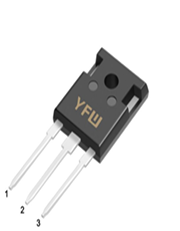Principle of Ultra-Fast Recovery Diode
Date:2025-05-16 Categories:Product knowledge Hits:447 From:Guangdong Youfeng Microelectronics Co., Ltd
1. Introduction
Ultra - fast recovery diodes (UFRDs) play a crucial role in modern power electronics systems. Their unique characteristics, especially the extremely short reverse recovery time, make them indispensable components for high - frequency rectification, freewheeling in switching power supplies, and various converter applications. Understanding the principle of UFRDs is fundamental to optimizing power electronic circuit designs and improving system efficiency.
2. Basic Structure and Material
2.1 Structure
Ultra - fast recovery diodes are typically fabricated using a semiconductor structure similar to conventional diodes but with specific modifications. They usually consist of a p - n junction. The p - type semiconductor has an excess of holes (positive charge carriers), while the n - type semiconductor has an excess of electrons (negative charge carriers). The key to the ultra - fast recovery characteristic lies in the epitaxial layer design and the doping profile around the p - n junction. In
Ultra - fast recovery diodes, a lightly doped n - drift region is often introduced between the p - type and n - type regions. This drift region helps control the carrier concentration and movement, which is essential for reducing the reverse recovery time.
2.2 Material
Silicon (Si) has been the traditional material for fabricating diodes due to its well - understood properties and mature manufacturing processes. However, with the increasing demand for higher performance, wide - bandgap materials such as silicon carbide (SiC) and gallium nitride (GaN) are also being used in the production of
Ultra - fast recovery diodes. SiC and GaN offer superior electrical properties, including higher breakdown voltage, lower on - resistance, and faster carrier recombination rates, which further enhance the performance of UFRDs, especially in high - voltage and high - frequency applications.

Previous:
Classification, Structure, and Principle of MOSFET
Next:
Forward - Conducting Operation
